a298927be050c582e1f89f960d155432.ppt
- Количество слайдов: 130

Myths About Suicide Thomas Joiner, Ph. D. The Robert O. Lawton Distinguished Professor of Psychology Department of Psychology Florida State University joiner@psy. fsu. edu



Suicide may just be the most stigmatized of human activities – it is even more stigmatized than appalling things like slavery and murder – and therefore a powerful mythology has arisen around it.

The stigma can be seen in many ways: Bereaved experience a change in their address books, as people they thought they could count on avoid them.

So let’s just do away with stigma, right?

Not only is it not easy, but stigma = fear + ignorance

Some things in nature should be feared, do deserve a healthy dose of respect

Fears are wired into us, and this wiring can be sensitive

Moreover, the lack of fear characterizes some of our most deranged and dangerous individuals.

Further still, in my book Why People Die By Suicide, I argued that the loss of fear – at least of physical pain, physical injury, and death – removes a barrier to suicide, and is therefore dangerous.



¨ Cobain was temperamentally fearful – afraid of needles, afraid of heights, and, crucially, afraid of guns. Through repeated exposure, a person initially afraid of needles, heights, and guns later became a daily self-injecting drug user, someone who climbed and dangled from 30 foot scaling during concerts, and someone who enjoyed shooting guns.

¨ Regarding guns, Cobain initially felt that they were barbaric and wanted nothing to do with them; later he agreed to go with his friend to shoot guns but would not get out of the car; on later excursions, he got out of the car but would not touch the guns; and on still later trips, he agreed to let his friend show him how to aim and fire. He died by self-inflicted gunshot wound in 1994 at the age of 27.

¨ Mental disorders, which spur death by suicide, are forces of nature, and thus deserve our respect and even fear (but not our resignation).

Let’s Leave Fear Be ¨ Stigma = fear + ignorance

Decreasing Ignorance via Dismantling of Myths ¨ Many myths about suicide are so ingrained that we may not be able to reduce ignorance until we undo these myths.

Categories of Myths ¨Myths about the suicidal mind ¨Myths about suicidal behavior ¨Myths about the nature of suicide

Myths About the Suicidal Mind ¨ MYTH: Suicide is primarily about – Cowardice – MYTH!!! – Weakness – MYTH!!! – Revenge – MYTH!!! – Selfishness – MYTH!!! – Self-Control – MYTH!!! – Impulsivity – MYTH!!!

Myths About Suicidal Behavior ¨ MYTH: Suicide is primarily characterized by – Note leaving – MYTH!!! – “Slow” forms of suicide (e. g. , smoking) – MYTH!!! – “Rational” suicide – MYTH!!! – A cry for help – MYTH!!! – Complete resolve and intent to die – MYTH!!!

Myths About the Nature of Suicide ¨ MYTH: Suicide is – Limited to humans – MYTH!!! – Not seen in young children – MYTH!!! – Caused by things like breast augmentation – MYTH!!! – More common in winter – MYTH!!!

Myths About the Suicidal Mind ¨ MYTH: Suicide is primarily about – Cowardice – MYTH!!! – Weakness – MYTH!!! – Revenge – MYTH!!! – Selfishness – MYTH!!! – Self-Control – MYTH!!! – Impulsivity – MYTH!!!

Sketch of the Theory Those Who Desire Suicide Perceived Burdensomeness Those Who Are Capable of Suicide Thwarted Belongingness Serious Attempt or Death by Suicide

Suicide Requires Fearlessness; Cowardice Will Prevent It ¨ Death by any means – including suicide – is fearsome and daunting. We are self-preserving creatures, wired in our cells and souls to fear death. ¨ Even intently and deeply suicidal people are subject to this fear, as we will see.

Suicide Requires Fearlessness; Cowardice Will Prevent It ¨The fearlessness is specifically about physical pain, physical injury, and death, and this fearlessness is distinct from concepts like courage, bravery, and heroism.

Why I Jumped by Tina Zahn ¨ In the midst of a recurrent, very severe (at times near-catatonic) postpartum depression, Zahn decided to jump off a bridge near Green Bay, Wisconsin. ¨ She fled relatives in her car, who called police. Police clocked her at 120 mph. ¨ Still, she is ambivalent, some signs of which show up in the following video.

The Documentary The Bridge Photographer saves someone who is pondering jumping from the Golden Gate Bridge. ¨ Here too, behavioral indicators of ambivalence. ¨

Incident at Train Tracks ¨Person balks at the last moment, thus saving her life.

Meriwether Lewis (of Lewis & Clark fame) ¨ From Stephen Ambrose’s biography of Lewis, Undaunted Courage: – Lewis paced for several hours (agitation), as others could hear him all night as the floorboards creaked. – Two self-inflicted gunshot wounds, neither fatal. – Servants found him “busily cutting himself from head to foot. ” – Lewis said to servants, “I am no coward, but I am strong, it is so hard to die. ” He died a few hours later.

Hesitation Wounds ¨ What are they? ¨ Virtually everyone who dies by self- inflicted knife wound has hesitation wounds around the site of the lethal injury. ¨ Why do even intently suicidal people hesitate (and some are saved during hesitation)? They hesitate because they feel fear.

Suicide in Anorexia Nervosa ¨ Mortality is extremely high in anorexic women (SMR = ~60). ¨ It is an under-appreciated fact that, should an anorexic patient die prematurely, the cause of death is more likely to be suicide than complications arising from compromised nutritional status.

Suicide in Anorexia Nervosa ¨ There at least two possible accounts of the high association between AN and suicide. In one view, anorexic women die by suicide at high rates because they are unable to survive relatively low lethality attempts and/or they may be less likely to be rescued after an attempt due to their socially isolated status.

Suicide in Anorexia Nervosa ¨ In another view, informed by my theory of suicidal behavior, anorexic women die by suicide at high rates because their histories of selfstarvation habituate them to pain and inure them to fear of death, and they therefore make high lethality attempts with high intent-to-die.

Suicide in Anorexia Nervosa ¨ We pitted these two accounts against each other, in a study of 239 women with AN, followed over ~15 years. ¨ 9 died by suicide, the leading cause of death among the sample. ¨ Of these 9, were they mostly highly lethal methods or not?

Suicide in Anorexia Nervosa ¨ The least lethal method: Ingestion of 12 oz. of a household cleaning product, along with an unknown amount of a powerful sedative and alcohol (BAC = 0. 16%). Cause of death was gastric hemorrhaging due to hydrochloric acid in the cleaning product. – 911 (intently suicidal feel fear too). – Might Bitrix have prevented this?

Myths About the Suicidal Mind ¨ MYTH: Suicide is primarily about – Cowardice – MYTH!!! – Weakness – MYTH!!! – Revenge – MYTH!!! – Selfishness – MYTH!!! – Self-Control – MYTH!!! – Impulsivity – MYTH!!!

Myths About the Suicidal Mind ¨ The Impulsivity Myth – Three instructive incidents • Christine Chubbuck • David Foster Wallace • Skydiving incident

Christine Chubbuck ¨ MYTH: She died by suicide impulsively, on live TV, while reporting the local news.

Christine Chubbuck ¨ TRUTH: She died by suicide on live TV, while reporting the local news, after a very long process of planning and deliberation.

Christine Chubbuck ¨Suicide attempt four years before her death. ¨Frequent talk of suicide. ¨Asked police officer about lethality of wound site. ¨A week before death, bought a gun.

Christine Chubbuck ¨Days before death, she “joked” with colleague about shooting herself on the air. ¨Day of death, stowed gun in prop bag, and brought it to the newsdesk.

Christine Chubbuck ¨ TRUTH CONTINUED: One aspect of her death contained an impulsive element, the basis on which her death has been misunderstood.

David Foster Wallace ¨Severe major depressive disorder, very well controlled for nearly 20 years by MAOI.

David Foster Wallace ¨When illness was well controlled, he did his life’s work, including Infinite Jest (all 1104 pages of it), work which in part won him a Mac. Arthur fellowship.

David Foster Wallace ¨MYTH: He died by suicide impulsively; in a brief window of time when his wife left their house, he impulsively died by hanging.

David Foster Wallace ¨ TRUTH: He made the disastrous decision to go off of MAOI, could not get illness back under control, and died by suicide over a year later.

Intently Suicidal People Know That Death Is Difficult to Enact Many documented cases of people who take planful steps to prevent their bodies from reacting and saving them (e. g. , binding hands before death by hanging). ¨

Skydiving Incident in New York State MYTH: Man went with friends to take pictures as the friends skydived; he impulsively jumped to his death from the plane. ¨

Skydiving Incident in New York State TRUTH: Man was not friends with others; had asked pilot if he could board and take photos the week before; had asked others their preference between jumping from a building vs. a plane. ¨

Sources of the Impulsivity Myth ¨Empirical link (correlation and causation). ¨“Out of the blue” appearance. ¨May ease bereavement.

Myths About the Suicidal Mind ¨ MYTH: Suicide is primarily about – Cowardice – MYTH!!! – Weakness – MYTH!!! – Revenge – MYTH!!! – Selfishness – MYTH!!! – Self-Control – MYTH!!! – Impulsivity – MYTH!!!

Misunderstanding Suicide as Selfish ¨ Suicide “is generally prompted by the most sordid and unworthy selfishness. It is a crime which sacrifices everything on the altar of individual feeling. ” Samuel Miller, 1805, Presbyterian minister.

Sketch of the Theory Those Who Desire Suicide Perceived Burdensomeness Those Who Are Capable of Suicide Thwarted Belongingness Serious Attempt or Death by Suicide

Perceived Burdensomeness ¨Essential calculation: “My death is worth more than my life to my loved ones/family/society. ”

Perceived Burdensomeness: Empirical Evidence ¨ Many studies to date have directly tested this view; all support it. – For example, we trained raters to evaluate actual suicide notes regarding the following dimensions: perceived burdensomeness; hopelessness; and generalized emotional pain. Unknown to the raters, half of the notes were from people who died by suicide, and half were from people who attempted suicide and survived. The notes from those who died by suicide contained more perceived burdensomeness than notes from attempters; no effects were found regarding hopelessness and emotional pain. Joiner et al. (2002). Perceived burdensomeness and suicidality: Two studies on the suicide notes of those attempting and those completing suicide. Journal of Social & Clinical Psychology, 21, 531 -545

Perceived Burdensomeness: Empirical Evidence ¨Other research too has supported this link. – For example, Brown, Comtois, & Linehan (2000) reported that genuine suicide attempts were often characterized by a desire to make others better off, whereas non-suicidal selfinjury was often characterized by desires to express anger or punish oneself. Brown, M. Z. , Comtois, K. A. , & Linehan, M. M. (2002). Reasons for suicide attempts and nonsuicidal self-injury in women with borderline personality disorder. Journal of Abnormal Psychology, 111, 198 -202.

Perceived Burdensomeness: Anecdotal Evidence ¨ Among the Yuit Eskimos of St. Lawrence Island, to become too sick, infirm, or old may threaten the group’s survival (i. e. , burden the group); the explicit and socially sanctioned solution to this problem is ritual suicide. The ritual is graphic, often involving the family members’ participation in the shooting or hanging of the victim

Perceived Burdensomeness: Anecdotal Evidence ¨ Burn victim: "I felt my mind slip back into the same pattern of thinking I'd had when I was fourteen [when he attempted suicide]. I hate myself. I'm terrible. I'm not good at anything. There's no point in me hanging around here ruining other people's lives. I've got to get out of here. I've got to figure out a way to get out of my life. "

Misunderstanding Selfishness ¨Confusing selfishness with cognitive constriction. –Car crash incident. –“Suicide is painless” incident.

Misunderstanding Selfishness ¨“Persons of great dignity and pride may find it necessary to destroy their own lives under circumstances in which those with a shallower scope of feeling can adjust with only moderate damage. ” – Hervey Cleckley, 1941, The Mask of Sanity.

Speaking of Cleckley What is the most selfish mental disorder? “Cleckley psychopathy” (cf. DSM-5 proposed revision). In what disorder do virtually no suicides occur? “Cleckley psychopathy. ” - prisoner video

Speculations on the Suicidal Mind An inward gaze of bemused resignation and resolution. ¨

Speculations on the Suicidal Mind

Speculations on the Suicidal Mind

Death and Life Merging ¨Cobain: “I am my own parasite. ” ¨ Plath: “The woman is perfected. / Her dead/Body wears the smile of accomplishment…/her bare/ feet seem to be saying: / we have come so far; it is over. ”

Categories of Myths ¨Myths about the suicidal mind ¨Myths about suicidal behavior ¨Myths about the nature of suicide

Myths About Suicidal Behavior ¨ MYTH: Suicide is primarily characterized by – Note leaving – MYTH!!! – “Slow” forms of suicide (e. g. , smoking) – MYTH!!! – “Rational” suicide – MYTH!!! – A cry for help – MYTH!!! – Complete resolve and intent to die – MYTH!!!

Suicide Notes ¨ MYTH: Those who die by suicide usually leave a note. ¨ TRUTH: Note-leaving is rare; approximately 20% of people who die by suicide leave a note.

Why Are Suicide Notes Rare? ¨ Alienation/isolation. ¨ Misery makes it hard to think straight and thus hard to write anything, especially something as momentous as a final goodbye. ¨ It’s not impulsivity – we already dealt with that, and, carefully planned deaths with no note are common.

Suicide Note Excerpts ¨ “I will give you $5000, that’s what I figured I owe you. I left your contract and listings on the desk; ” ¨ “Please call the police before you open the door, I have shot myself; ” ¨ “Police, my car keys are in my pocket. Please drive my car home. My daughter needs it to drive back-and-forth to work; ” ¨ “You have my permission to withdraw all my savings etc. to pay off bills. ”

Suicide Note Excerpts ¨ The commonality? – Concrete – Cognitively Constricted Compare to “Suicide is painless, ” a fake note.

Myths About Suicidal Behavior ¨ MYTH: Suicide is primarily characterized by – Note leaving – MYTH!!! – “Slow” forms of suicide (e. g. , smoking) – MYTH!!! – “Rational” suicide – MYTH!!! – A cry for help – MYTH!!! – Complete resolve and intent to die – MYTH!!!

“Slow” Suicide

“Slow” Suicide Why did Farley (and so many others, famous and lesser known alike) continue very extensive use of drugs that he had been told and understood may well kill him? It was not be because he liked death, it was because he liked drugs – he liked them so much that the risks be damned.

“Slow” Suicide Why do people who know they should not smoke anymore do so anyway, at great risk to their lives? It is not because they like death, it is because they like smoking.

“Slow” Suicide Why do anorexic women persist in their behavior despite everyone advising them not to? It is not because they want to die, but rather, they are “dying to be thin. ” - video

“Slow” Suicide Crucial concept is intent. Suicidal people intend to die (though they retain ambivalence, as we have seen). Smokers, anorexics, etc. , intend other things.

Myths About Suicidal Behavior ¨ MYTH: Suicide is primarily characterized by – Note leaving – MYTH!!! – “Slow” forms of suicide (e. g. , smoking) – MYTH!!! – “Rational” suicide – MYTH!!! – A cry for help – MYTH!!! – Complete resolve and intent to die– MYTH!!!

“Rational” Suicide ¨ “in the large proportion of cases, if not the majority, suicide is committed by sane people. ” John Gray, 1871, American Journal of Insanity. ¨ But what did he mean by “sane? ”

“Rational” Suicide ¨By “sane, ” he meant non-psychotic. ¨His view is thus compatible with mine: Virtually everyone, very close to 100%, who dies by suicide has a mental disorder or subclinical variant thereof at the time of death.

“Rational” Suicide ¨If “virtually everyone” is defined as greater than 90%, there is wide consensus on this point. ¨It is the remaining 10% or so that are in question. Some feel that some “rational” suicides occur in this subset; I believe this subset all have mental disorders.

“Rational” Suicide ¨What is a “partial syndrome” or “subclinical variant” of mental disorders? ¨Consider this case example: – Insomnia – Suicidal ideas – Feelings of sadness

“Rational” Suicide ¨Imagine further that the insomnia is noticed by the spouse but brushed off and dismissed because the person says “it’s nothing. ” The suicidal ideas and feelings of sadness are not disclosed to anyone.

“Rational” Suicide The person dies by suicide, leaving a note saying, “For the record, I do not have a mental disorder. ” Did he though? And will the family believe his was a “rational” suicide (and that it was impulsive by the way)?

Myths About Suicidal Behavior ¨ MYTH: Suicide is primarily characterized by – Note leaving – MYTH!!! – “Slow” forms of suicide (e. g. , smoking) – MYTH!!! – “Rational” suicide – MYTH!!! – A cry for help – MYTH!!! – Complete resolve and intent to die – MYTH!!!

The “Cry for Help” Myth ¨ Consider this statement, which contains a certain truth, but also may be misinterpreted to indirectly perpetuate the myth: “While in most suicide cases people have given verbal or behavioral clues that they intend to take their lives, suicide researchers agree that most people expressing verbal threats will not in fact attempt it” (Timmermans, 2006, p. 184).

The “Cry for Help” Myth ¨ The first part of the sentence is clear and right on target: When people give off clues about their impending suicide, it is a serious situation indeed. The second part of the sentence, read closely and literally, is true as well: Of all the people who experience the desire for suicide, even to the point of voicing it to others, only a proportion go on to actually die. This is quite right, just as it is quite right that, of all the people who experience severe chest pain, only a proportion (and a pretty small proportion at that) will go on to die from a heart attack.

The “Cry for Help” Myth ¨ A key point is that, in the case of severe chest pain, it is relatively rare for the reaction to be “he’s faking!” or “she’s just trying to get attention!” Indeed, most people would find these reactions cruel, rightly. And this despite the fact that a sizable proportion of chest pain scenarios actually are false alarms, with the discomfort caused by anxiety, a panic attack, esophageal problems, and so forth. In the case of suicide threat, it is common for the threat to be dismissed, and an underappreciated fact is that this represents playing with fire, just as ignoring or dismissing chest pain can be.

The “Cry for Help” Myth ¨Gene from “The Bridge”

Myths About the Nature of Suicide ¨ MYTH: Suicide is – Limited to humans – MYTH!!! – Not seen in young children – MYTH!!! – Caused by things like breast augmentation – MYTH!!! – More common in winter – MYTH!!!

Perceived Burdensomeness: Self. Sacrifice Across Species ¨Fire ants. ¨Pea aphids. ¨Lions. ¨Spiders ¨…. even bacteria and a palm tree. – Slime mold video

Perceived Burdensomeness: Self. Sacrifice Across Species ¨ In several types of bacteria, there are cells that produce chemicals that kill both themselves and those genetically unrelated to the “suicidal” bacterium.




Strengthening Belongingness ¨ New CDC vision: Promote connectedness – The degree to which a person or group is socially close, interrelated, or shares resources with other persons or groups • Between individuals/families and community organizations • Among community organizations and social institutions



Those Who Desire Suicide Perceived Burdensomeness Those Who Are Capable of Suicide Thwarted Belongingness Serious Attempt or Death by Suicide





Going Back to Answer Questions: Suicide Terrorists ¨ It is clear that suicide terrorists and bombers work up to the act, going through months and sometimes years of training and preparation for the act; in this way, they are consciously and deliberately attaining the capability for lethal behavior.
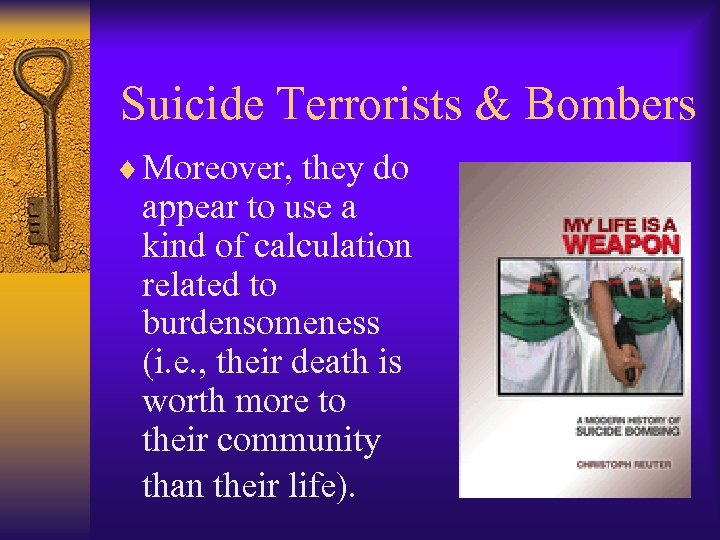
Suicide Terrorists & Bombers ¨ Moreover, they do appear to use a kind of calculation related to burdensomeness (i. e. , their death is worth more to their community than their life).

Suicide Terrorists & Bombers ¨ Their sense of belongingness, however, seems quite high – another reason, from the perspective of the current model, to view their deaths as other than suicides, and many Muslim clerics concur that self-martyrdom and suicide are distinct (Kelsay, 2002).
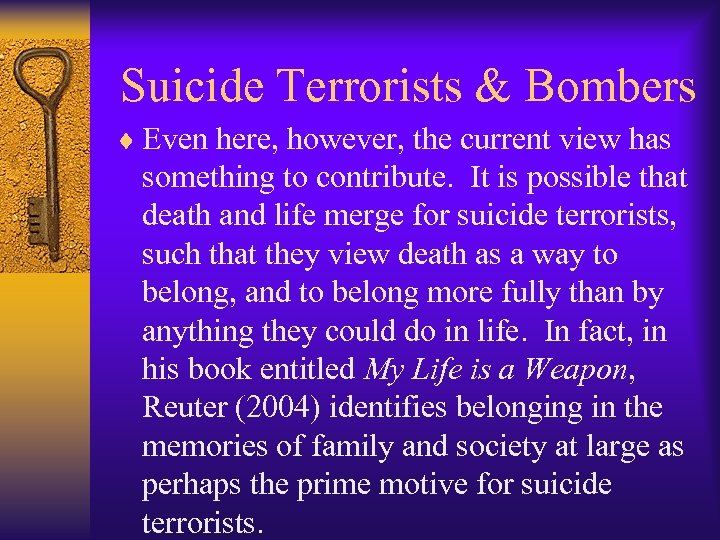
Suicide Terrorists & Bombers ¨ Even here, however, the current view has something to contribute. It is possible that death and life merge for suicide terrorists, such that they view death as a way to belong, and to belong more fully than by anything they could do in life. In fact, in his book entitled My Life is a Weapon, Reuter (2004) identifies belonging in the memories of family and society at large as perhaps the prime motive for suicide terrorists.

Suicide Terrorists & Bombers ¨ Japanese kamikaze pilots can be viewed similarly. Axell and Kase (2002) published excerpts from the pilots’ “howto” manual. One excerpt read, “Just before the collision it is essential that you do not shut your eyes for a moment so as not to miss the target. Many have crashed into the targets with wide-open eyes. They will tell you what fun they had. ”

Suicide Terrorists & Bombers ¨A subsequent passage entitled “The moment of the crash” read, “You are two or three meters from the target. You can see clearly the muzzles of the enemy’s guns. You feel that you are suddenly floating in the air. At that moment, you see your mother’s face. ”

Suicide Terrorists & Bombers ¨ Also like the suicide bombers, high belongingness seemed to characterize the deaths of Kamikaze pilots. A relevant excerpt from their manual read, “Remember when diving into the enemy to shout at the top of your lungs: “Hissatsu!” (“Sink without fail!”) At that moment, all the cherry blossoms at Yasukuni shrine in Tokyo will smile brightly at you. ”

Suicide Terrorists & Bombers ¨According to my model, one interpretation of this is that the pilots’ need to belong has become met by death. Another interpretation, of course, is that their elevated sense of belongingness is a reason to define their deaths as other than suicides.

Thank you for your attention ¨joiner@psy. fsu. edu

Jackson Pollock’s Blue Poles (1952)

Jackson Pollock’s Blue Poles (1952) This work was conceived and begun in the midst of a serious, alcohol-related suicidal crisis, and eventually sold for more than $2 million – at the time, only works by Rembrandt, Velazquez, and da Vinci had sold for more.

Jackson Pollock’s Blue Poles (1952) Poetic and romantic, right? Wrong: Pollock spent months undoing and redoing the work of the night of the crisis.

Jackson Pollock’s Blue Poles (1952) Pollock’s career was cut short when he died in an alcohol-related, single car crash in Springs, New York on August 11, 1956 at the age of 44. One of his passengers also died.
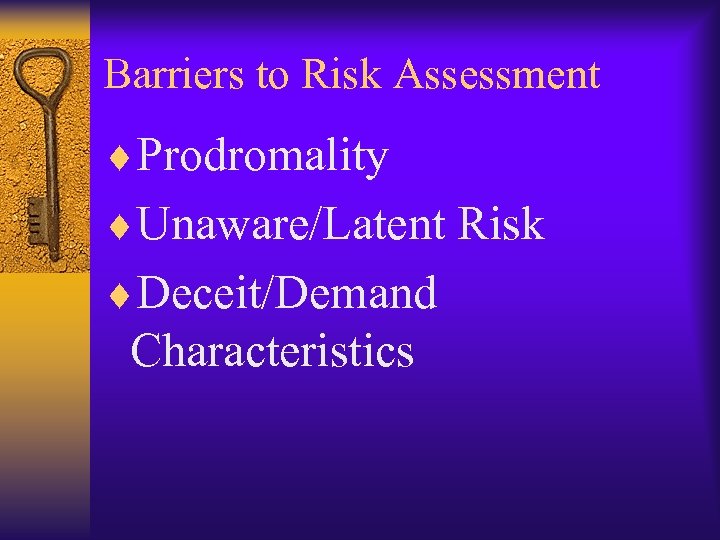
Barriers to Risk Assessment ¨Prodromality ¨Unaware/Latent Risk ¨Deceit/Demand Characteristics

Distillation of Risk Factors ¨Talking about/planning suicide (safety planning) ¨Agitation (benzos) ¨Insomnia (sleep hygiene) ¨Nightmares (rescripting) ¨Marked social withdrawal (list of 300). – Motivational Interviewing

Nightmares ¨ I could be bound in a nutshell And count myself a king of infinite space were it not that I have bad dreams. - from Hamlet


Distillation of Risk Factors ¨Two others to consider (but less strongly): –Humiliation –Anger (marked increase)

Distillation of Risk Factors ¨What’s not listed? – Sluggishness • Hopelessness • Depression

Charting ¨ Quod non est in actis, non est in mundo (roughly, that which is not recorded did not happen).

Informed Consent “If you’re presenting with some form of suicidality (i. e. suicidal thinking or a suicide attempt), it’s important to recognize the risks inherent in treatment, as well as a decision not to seek treatment. Randomized controlled trials for the treatment of suicidality have found re-attempt rates during treatment as high as 47%, with a number of experimental treatments significantly reducing the rate of subsequent attempts by as much as half. The risk of a suicide attempt during treatment is greatest for those who have made multiple suicide attempts (i. e. two or more)…”
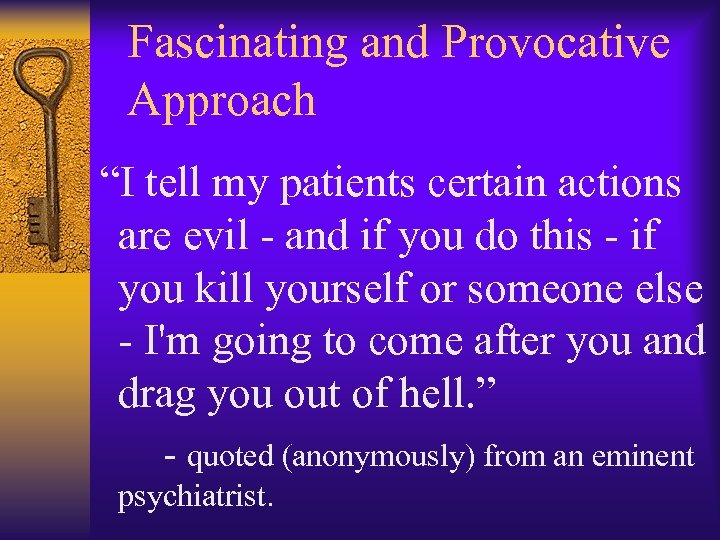
Fascinating and Provocative Approach “I tell my patients certain actions are evil - and if you do this - if you kill yourself or someone else - I'm going to come after you and drag you out of hell. ” - quoted (anonymously) from an eminent psychiatrist.

Fascinating and Provocative Approach “My patients - to a man and woman - are both astonished that a psychiatrist would make a judgment about good and evil in the present day and are comforted that someone cares enough about them and their life to try to do everything possible to protect and sustain it. The point is usually being made in the midst of therapeutic planning and I back it up with my availability to them during the crisis and its resolution that has prompted their sense of despair. Try it, you'll like it. ” - quoted (anonymously) from an eminent psychiatrist.

An empirically validated treatment for resolving suicidal behavior (cont. ) ¨“Assume a virtue if you have it not, for use can almost change the stamp of nature. ” - From Shakespeare’s Hamlet
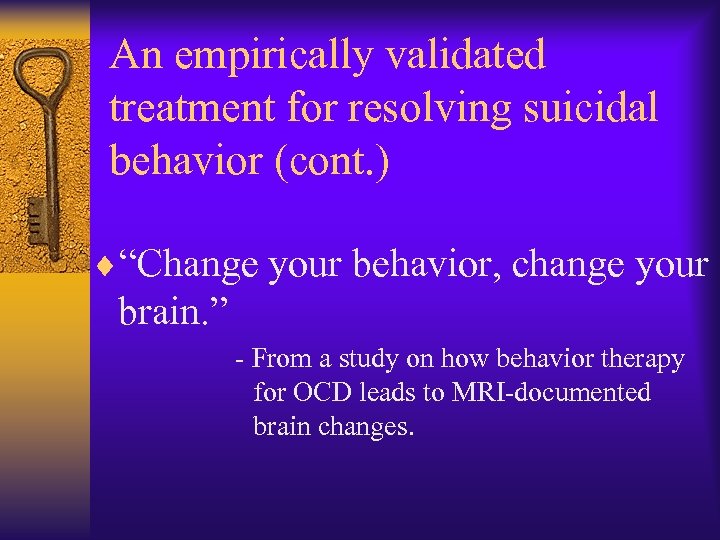
An empirically validated treatment for resolving suicidal behavior (cont. ) ¨“Change your behavior, change your brain. ” - From a study on how behavior therapy for OCD leads to MRI-documented brain changes.

Thank You! joiner@psy. fsu. edu
a298927be050c582e1f89f960d155432.ppt